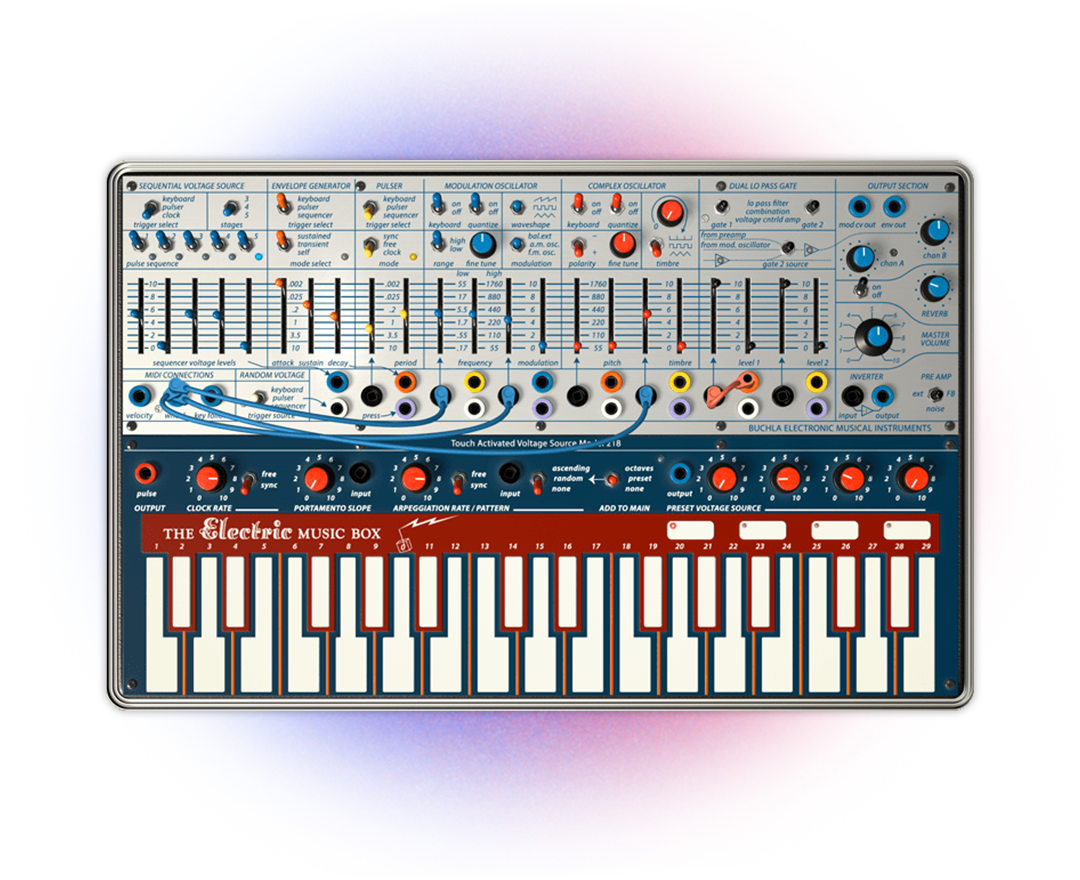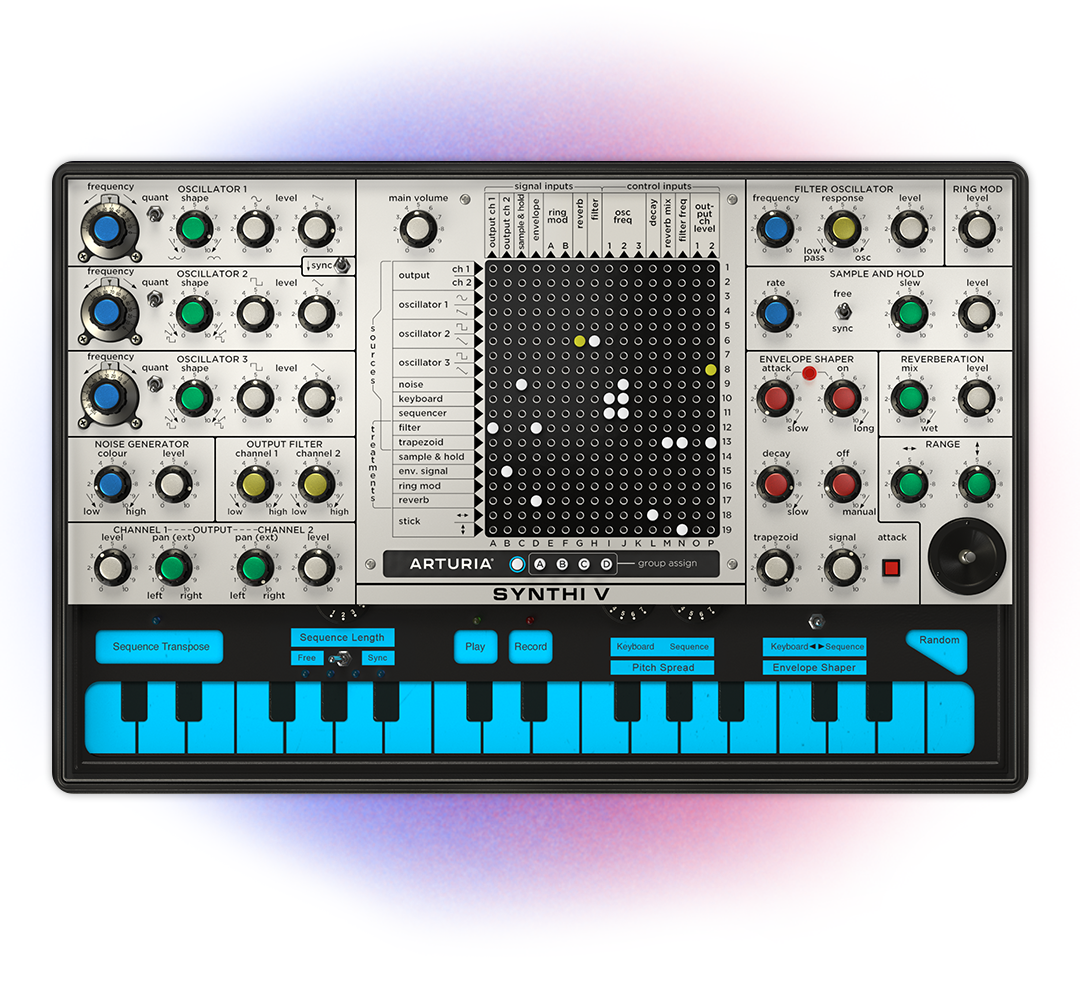Illustration: Yann Bastard
V Collection is Arturia’s acclaimed synth, organ, piano, and performance keyboard anthology.
Mapping out every circuit, component, and nuance, V Collection 8 boasts meticulous emulations of a whopping 28 classic keyboards. Each instrument featured in V Collection 8 is legendary in its own right, possessing a rich history and unmistakable sound. In this blog post, let’s explore seven of these emulations and their analog counterparts, including three keyboards that are brand-new additions to V Collection’s roster.
The Mellotron / Mellotron V

The Mellotron could be considered the music industry’s first sampler, with a history that’s as complex as the original machine itself. Harry Chamberlin originally developed and patented a keyboard that could play tape loops in the 1940s. However, in 1962, Chamberlin’s sales agent Bill Fransen spoke with employees of the tape engineering company Bradmatic Ltd, who decided to create their own copy of the instrument with the misunderstanding that the owner of the concept was Fransen, rather than Chamberlin. They formed a new company, Mellotronics, and recorded full orchestras for the product launch. The Mellotron MK1 was released in 1963, and Chamberlin and Mellotronics subsequently agreed out-of-court to continue manufacturing each instrument independently.
The Mellotron soon grew in popularity amongst rock musicians – The Beatles most famously used it on “Strawberry Fields Forever,” and other spotlights include the strings on David Bowie’s “Space Oddity,” the signature cellos of Oasis’ “Wonderwall,” and the choir sounds in Radiohead’s “Exit Music (For a Film).”
The original instrument was famously impossible to tune – factors like room temperature, smoke, and humidity tended to wear down the tapes and the tape head. Thankfully, you won’t have this problem with Arturia’s brand-new recreation, the Mellotron V. In fact, you can even load up your own samples, with the original machine’s wonderfully realistic flutters and tape delays still intact.
The Prophet-5 / Prophet V

Sequential Circuits’ Prophet-5 lives up to its name, representing a visionary look into music’s future. The Prophet-5 was the world’s very first fully-programmable polyphonic synthesizer, making it the grandfather to your favorite Serum plugin, your beloved Microkorg, and your prized Massive patch. The instrument was created by Dave Smith in 1977, and premiered at NAMM a year later. The original model included five voices of polyphony, with each voice coming with two VCOs that could generate sawtooth, square, and triangle waves.
The Prophet-5 can be heard on tons of iconic tracks, including Michael Jackson’s “Thriller” and the theme for John Carpenter’s “Halloween.” With Arturia’s Prophet V, you can now dive deep into the iconic pads, leads, and basses of Sequential Circuits’ flagship synth for a fraction of the price and a fraction of the weight.
The Wurlitzer Electric Piano / Wurli V

Though Mellotronics and Sequential Circuits are both manufacturers with products that have stood the test of time, Wurlitzer takes historical influence to another level. The company was founded way back in 1853, originally mainly importing German acoustic instruments for resale in the United States. As technology evolved, they began producing their own electronic instruments, with the Wurlitzer Electric Piano (commonly referred to as “the Wurly”) being one of them.
The Wurlitzer Electric Piano is known for its colorful sound; its reed-based build makes it a bright electric piano with a velocity-sensitive grit that gained popularity among rock and funk players. Arturia’s physically-modeled Wurli V faithfully reproduces the Wurlitzer’s sound, while also adding supplemental features such as tonal shaping, a guitar amp, a rotary speaker, and effects boxes.
The CZ-101 / CZ V

Released in 1984, Casio’s CZ-101 was the first and best-selling synth in its line. One of the first fully-programmable synths that could be acquired for under $500, the CZ-101 was popular among hobbyists in home studios throughout the 80s. That said, it was beloved by professionals in studios as well, who were drawn to the synth for its ease-of-use, pristine sounds, and built-in drums. Arturia’s CZ V, another new addition to V Collection 8, includes every nuance of the original, with the same wave types, patch programming, warbled vibrato, and more.
The Buchla Music Easel / Buchla Easel V

Buchla & Associates (now known as Buchla Electronic Musical Instruments) was founded by electronic music pioneer Don Buchla, and it’s undoubtedly one of the most renowned and recognized synth manufacturers out there. The Buchla Music Easel is one of the many instruments from their expansive catalog, created in 1973 for musicians who were in search of a powerful synth that was both performative and portable. Soon after its release, the Buchla Music Easel gained a dedicated following for its real-time control capabilities and left-field sound design.
Arturia’s Buchla Easel V gives you everything that the original instrument offers, down to the same patching capabilities for fine-tuning your sound. Arturia’s recreation also incorporates Gravity, a physics-based synth engine that takes the Buchla Music Easel’s sound even further.
The Yamaha CS-80 / CS-80 V

The Yamaha CS-80 was a contemporary of the Prophet-5, similarly sporting true polyphony and the ability to save patches. However, Yamaha’s instrument featured a keyboard that was not only velocity-sensitive, but also boasted aftertouch. It was beloved by Stevie Wonder, Toto, and ELO, but was perhaps most famously used by Vangelis. The Yamaha CS-80’s ability to create immersive ambient and droning textures paired wonderfully against the moody futurism of Ridley Scott’s Blade Runner. Composer Vangelis used the CS-80 almost exclusively for the soundtrack, using a brass patch with tons of lush timbres and long release times to accentuate the sci-fi classic’s smoky, film noir aesthetic.
The Synthi / Synthi V

Last but not least, we have to talk about the Synthi. Despite its compact size, the Synthi made a big impact when EMS launched it in 1972. Its portability, unique patch pin matrix, and massive, unpredictable sound was like no other. It quickly became the instrument of choice for groundbreaking musicians including Brian Eno, Pink Floyd, and Jean-Michel Jarre. Arturia’s Synthi V is the third and final new addition to V Collection 8 that makes EMS’ Synthi even more portable, while also bringing additional features including advanced modulation and powerful effects.
Though we highlighted a total of seven keyboards here, there are a ton more iconic instruments available in Arturia’s V Collection. Explore the full collection on Rent-to-Own, and get your hands on every instrument for just $24.99/mo.
Explore royalty-free one-shots, loops, FX, MIDI, and presets from leading artists, producers, and sound designers:
April 25, 2019



